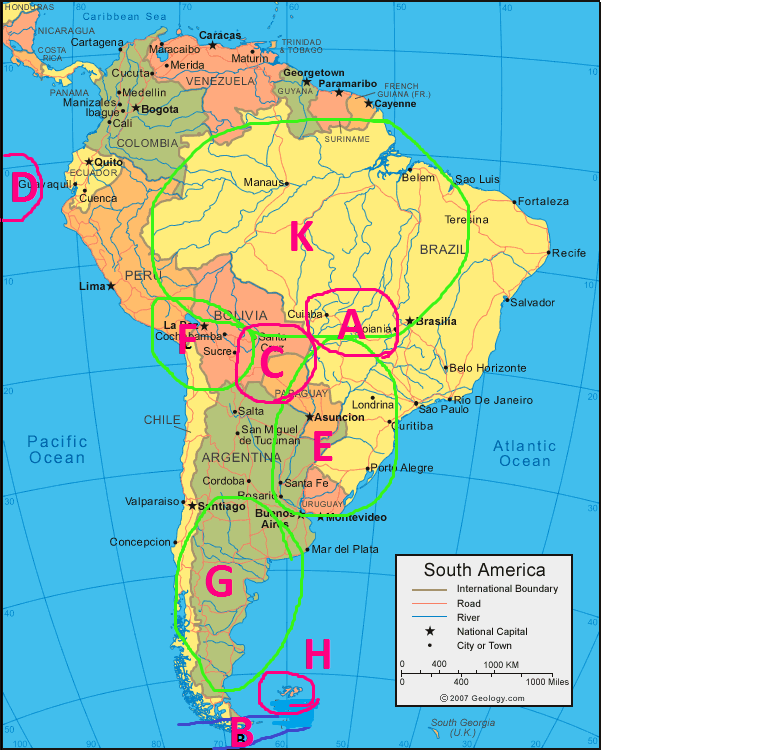Physical Geography: Definition, Major Concepts, and Earth Systems
Lesson Overview
- What Is the Importance of Physical Geography?
- What Are Earth's Structural Elements?
- What Are the Major Types of Landforms and Geomorphological Processes?
- How Do Weather, Climate, and Climatology Interact?
- What Constitutes Water Systems and Hydrology?
- What Defines Biogeography and Soil Science?
- What Is the Human Impact on Physical Geography?
- Case Studies in Physical Geography
Physical geography is the scientific study of Earth's natural features and processes. It focuses on understanding the Earth's structure, including its atmosphere, hydrosphere, biosphere, and geosphere, and how these elements interact to shape our environment. This field examines patterns like climate, landforms, water flow, and vegetation, and how these patterns influence and are influenced by human activities.
Physical Geography Examples
- Mountain Ranges
Himalayas, Andes, Rockies - formed by tectonic activities. - Rivers and Lakes
Amazon River, Mississippi River, Lake Baikal - vital water bodies influencing landscapes and ecosystems. - Deserts
Sahara, Gobi, Sonoran - characterized by arid environments and unique geomorphological features. - Glaciers and Ice Caps
Greenland Ice Sheet, Patagonia glaciers - impact on global sea levels and climate. - Volcanoes: Mount Fuji, Kīlauea, Iceland's volcanic fields - shaped by geothermal activity.
- Coral Reefs
Great Barrier Reef, Mesoamerican Barrier Reef - rich in marine biodiversity and coastal protection. - Wetlands
Everglades, Pantanal, Sundarbans - critical for wildlife habitat and natural water regulation. - Tundra
Arctic and alpine tundra - known for cold climates and permafrost. - Rainforests
Amazon, Congo - crucial for global biodiversity and climate regulation. - Grasslands
North American prairies, African savannahs, Central Asian steppes - vast areas with distinct ecosystems.
Take This Quiz
What Is the Importance of Physical Geography?
Physical geography is essential for understanding the Earth's processes and managing natural resources, human settlements, and ecosystems.
Understanding Natural Processes
Physical geography helps us comprehend processes like climate dynamics, water cycles, and geological activities, which are crucial for predicting weather, managing climate change, and using natural resources.
Environmental Management
It aids in managing natural environments, conserving ecosystems, and balancing human needs with environmental protection, such as sustainable land use, protecting biodiversity, and water management.
Disaster Mitigation
By studying physical geography, we can better predict natural disasters like hurricanes, earthquakes, and floods, reducing their impact on people and property.
Agricultural Planning
Knowledge of physical geography aids in soil management, selecting crops suited to climates and terrain, and supporting sustainable farming practices.
Urban Planning
Physical geography guides urban planning, helping to determine suitable infrastructure locations and preventing environmental hazards like flooding and land subsidence.
Climate Science
Physical geography contributes to climate science by providing essential data for modeling and predicting climate systems, crucial for global environmental policies.
Biodiversity Conservation
Studying ecosystems and species distribution enables effective biodiversity conservation, protecting endangered species and maintaining ecological balance.
Educational Value
Physical geography fosters a deeper appreciation of the Earth's resources, promoting environmental stewardship and increasing awareness of global challenges.
Cultural Understanding
It helps us understand how natural landscapes influence human cultures, showing the interdependence between people and their environment.
Technological Applications
Technologies like Geographic Information Systems (GIS) and remote sensing rely on physical geography to analyze spatial data, supporting navigation, environmental monitoring, and decision-making.
What Are Earth's Structural Elements?
Earth's structural elements include the major components of our planet that shape its physical characteristics and sustain life. Here's a breakdown of these elements:
The Lithosphere: Earth's Crust and Plate Tectonics
- Definition: The lithosphere comprises Earth's crust and the upper part of the mantle. It forms the planet's outermost, rigid shell.
- Composition: Made up of tectonic plates, which include continental and oceanic crust.
- Plate Tectonics: Tectonic plates move over the asthenosphere, causing geological activities like earthquakes, volcanic eruptions, and mountain formations.
The Atmosphere: Composition and Weather Dynamics
- Definition: The atmosphere is a layer of gases surrounding Earth, held by gravity.
- Composition: Primarily nitrogen (78%) and oxygen (21%), with trace gases like carbon dioxide.
- Weather Dynamics: The atmosphere influences Earth's climate by redistributing heat from the sun, affecting temperature, precipitation, and wind patterns.
The Hydrosphere: Oceans, Rivers, and Water Cycle
- Definition: The hydrosphere includes all of Earth's water in various forms: liquid, vapor, and ice.
- Components: Oceans, rivers, lakes, groundwater, ice caps.
- Water Cycle: Describes the continuous movement of water through evaporation, condensation, precipitation, infiltration, and runoff.
The Biosphere: Ecosystems and Biodiversity
- Definition: The biosphere is the sum of all ecosystems, integrating all living beings and their interactions with the Earth's elements.
- Ecosystems: Biological communities interacting with each other and their physical environment.
- Biodiversity: The variety of life on Earth, crucial for ecosystem health, resilience, and providing resources like food, fiber, and medicine.
Take This Quiz
What Are the Major Types of Landforms and Geomorphological Processes?
Landforms are physical features of Earth's surface, shaped by geomorphological processes. These processes include erosion, weathering, deposition, and tectonic activities. Understanding these features is vital in physical geography.
Major Landforms
- Mountains: Elevated areas formed by tectonic forces, volcanic activity, or erosion.
- Plains: Flat areas formed by sediment deposition, typically with minimal elevation changes.
- Plateaus: Elevated flat areas, often formed by volcanic activity or tectonic uplift.
- Hills: Smaller, less steep than mountains, often formed by erosion and deposition.
- Valleys: Low areas between hills or mountains, shaped by erosion, particularly rivers.
- Deserts: Arid regions with little precipitation, often featuring sand dunes and rock surfaces.
- Coasts: Land meeting the ocean or sea, shaped by marine processes like tides and waves.
- Rivers and Lakes: Water bodies that shape the landscape through erosion and sediment deposition.
Geomorphological Processes
- Erosion: The removal of material from Earth's surface by wind, water, or ice, which transports the material to new locations.
- Weathering: The breakdown of rocks into smaller particles, influenced by chemical, physical, or biological processes.
- Deposition: The accumulation of material carried by wind, water, or ice, forming landforms like deltas and sand dunes.
- Tectonic Activity: Movements within Earth's crust, creating mountains, earthquakes, and oceanic trenches.
- Volcanic Activity: The eruption of material from beneath Earth's crust, forming volcanic mountains and plateaus.
- Glacial Processes: The movement of glaciers, which sculpt landscapes through processes like abrasion, creating U-shaped valleys and fjords.
How Do Weather, Climate, and Climatology Interact?
Weather, climate, and climatology describe atmospheric conditions at different scales and scopes. Understanding how they interact is essential in physical geography.
Weather
Weather refers to short-term atmospheric conditions (minutes to weeks), including temperature, precipitation, and humidity. It varies daily and is what people experience on a daily basis.
Climate
Climate represents the long-term average of weather patterns over at least 30 years. It includes temperature, precipitation, and other meteorological variables for a particular region.
Climatology
Climatology is the study of climate, analyzing historical weather patterns to predict future trends. Climatologists use data from various sources to model and forecast climate changes.
Interaction between Weather, Climate, and Climatology
- Data and Analysis: Weather data feeds into climatology to study long-term climate trends.
- Predictive Modeling: Climatologists use historical weather data to predict future climate conditions, influencing policy.
- Environmental Impact: Climate changes affect weather patterns, like increasing extreme weather events.
- Human Interaction: Understanding weather and climate helps societies prepare for and mitigate the effects of extreme weather.
What Constitutes Water Systems and Hydrology?
Water systems and hydrology are critical in physical geography, focusing on water distribution and movement across the Earth.
Water Systems
Water systems include all bodies of water, such as:
- Oceans: Cover 71% of Earth's surface and regulate climate.
- Rivers and Streams: Transport water across landscapes, vital for ecosystems and human use.
- Lakes: Inland water bodies crucial for drinking water and agriculture.
- Glaciers and Ice Caps: Store freshwater in polar regions.
- Groundwater: Water beneath the surface, critical for drinking and irrigation.
- Wetlands: Vital ecosystems that regulate water flow and provide wildlife habitat.
Hydrology
Hydrology studies water in the environment:
- Hydrological Cycle: Describes water movement through evaporation, precipitation, and runoff.
- Water Quality: Ensures safe drinking water by studying chemical and biological water characteristics.
- Hydrological Modeling: Simulates water flow to predict environmental changes.
- Watershed Management: Focuses on managing water resources in a given area.
- Hydrogeology: Studies water in Earth's crust, focusing on groundwater distribution and management.
Take This Quiz
What Defines Biogeography and Soil Science?
Biogeography
Biogeography examines species distribution across Earth, influenced by historical events, climate, and ecological factors. It helps in understanding how organisms adapt to their environment and supports conservation efforts.
Soil Science
Soil science studies soil formation, properties, and classification. It's essential for agriculture, land management, and environmental conservation:
- Soil Formation: Involves the weathering of rock and mixing with organic matter.
- Soil Classification: Categorizes soil based on texture, structure, and fertility.
- Soil Functions: Soils support plant growth, regulate water, and recycle nutrients.
What Is the Human Impact on Physical Geography?
Human activities have significantly altered the Earth's physical geography. Key areas of impact include:
Land Use Changes
Urbanization, agriculture, and deforestation reshape landscapes, affecting soil composition and ecosystems.
Water Resource Management
Dams, irrigation systems, and water diversion projects alter river courses and affect water distribution.
Pollution
Air, water, and soil pollution degrade natural environments and impact biodiversity.
Climate Change
Human-induced climate change is altering weather patterns and global climates, affecting ecosystems and human societies.
Mining and Extraction
Resource extraction reshapes landscapes, leading to soil degradation and topographical changes.
Infrastructure Development
Construction of roads and buildings modifies the landscape, increasing erosion and affecting water flow.
Invasive Species
Human activity introduces non-native species, disrupting ecosystems and biodiversity.
Soil Erosion
Deforestation and agriculture increase soil erosion, impacting water quality and habitat.
Case Studies in Physical Geography
Here are three detailed case studies that illustrate different aspects of physical geography and the human impact on natural system.
Everglades Restoration, USA: The restoration of Florida's Everglades has had mixed results in improving water quality and habitat.
Three Gorges Dam, China: While providing hydroelectric power, it has altered the landscape, displaced communities, and impacted biodiversity.
Deforestation in the Amazon: Efforts to reduce deforestation have been challenging, as illegal activities continue to threaten the Amazon.
Melting Glaciers in the Swiss Alps: Glaciers continue to retreat due to climate change, affecting water supply and tourism.
Take These Quizzes
Rate this lesson:
 Back to top
Back to top





(60).webp)